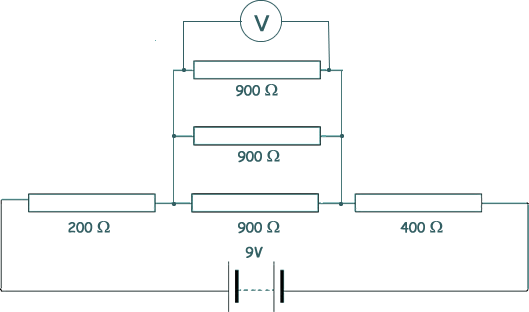Potential Division The 'voltage drop' from a power supply spreads itself out across components in a circuit strand 'fairly'. The component with the most resistance gets the biggest share of the total potential difference available. This results in a steady current through the wire strand. Being able to analyse the distribution of electric potential across a circuit allows you to 'analyse' circuits - it is a very useful art!
Let's work out what the voltage drop would be across the top 900Ω resistor - what would the voltmeter reading be?
The three 900Ω resistors in parallel with each other, will each have the same potential difference, as across a parallel arrangement all components have the same potential drop. But what will this be? It is not easy to see.
1/RTOTAL = 1/ R1 + 1/R2 + 1/R3 1/RTOTAL= 1/900 + 1/900 + 1/900 = 3/900 so, RTOTAL= 900/3 = 300Ω
Step 2
RTOTAL = R1 + R2 + R3 RTOTAL = 200Ω + 300Ω + 400Ω = 900Ω Step 3
Total potential drop = 9V Total resistance = 900 Ω Each ohm has 9/900 volts across it = 1/100 = 0.01V/Ω Step 4
- the 200 Ω resistor has a potential drop of 200 x 0.01 = 2V - the 300 Ω resistor (the resistor that replaced the parallel arrangement) has a potential drop of 300 x 0.01 = 3V - the 400 Ω resistor has a potential drop of 400 x 0.01 = 4V Step 5
It adds up to 9V so it looks okay! Step 6
The voltmemter would read 3V Now try some questions:Q1. Three resistors are in series 700 Ω, 300 Ω and 200 Ω. A potentail difference of 6V is applied across the arrangement. Calculate the potential drop across the 700 Ω resistor.
Q2. Three resistors are in series 900 Ω, 400 Ω and 700 Ω. A potential difference of 5V is applied across the arrangement. Calculate the potential drop across the 700 Ω resistor.
Q3. Two sets of resistors are in series with a single 300 Ω resistor. The first set is composed of two 900 Ω resistors in parallel with each other. The second set consists of a 400 Ω and 700 Ω resistor in parallel with each other. A potential difference of 10 V is applied across the arrangement. What is the voltage drop across the single 300 Ω resistor?
|
Follow me...
|







